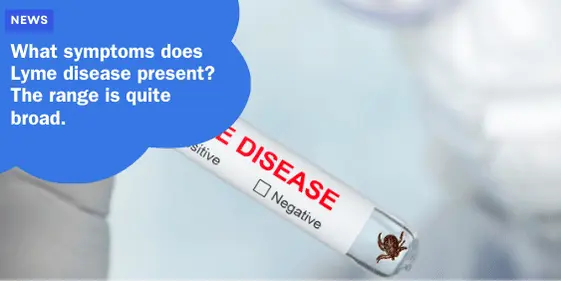What symptoms does Lyme disease present? The range is quite broad.

Before the global upheaval caused by the COVID-19 pandemic, many individuals suffering from post-infectious chronic illnesses struggled to have their conditions acknowledged and taken seriously by medical professionals.
Conditions such as long COVID-19, with symptoms including brain fog, dizziness, and fatigue, have drawn significant attention due to the massive number of affected individuals.
These symptoms often point towards dysregulation of the autonomic nervous system, a phenomenon also observed in other infections like Lyme disease.
The attention garnered by long COVID-19 has catalyzed interest among doctors and researchers, even though some have been treating and studying these conditions for years.
Lyme disease, both in its acute and chronic manifestations, remains a complex and nuanced issue.
To shed light on this medical enigma, we consulted several experts.
Symptoms of Lyme Disease
Dr. John Aucott, the director of the Johns Hopkins Lyme Disease Clinical Research Center, elaborates on the symptoms experienced during the acute phase of Lyme disease.
According to Dr. Aucott, the most recognizable symptom in this phase is the presence of a round red rash known as Erythema Migrans or the “Bulls-Eye Rash,” often appearing at the tick bite site.
Alongside this characteristic rash, patients may also exhibit general signs of infection such as fever, chills, malaise, and fatigue.
Dr. Aucott notes, “The rash is the distinguishing characteristic, but the rest of the symptoms don’t distinguish Lyme disease from other infections.”
Consequences of Untreated Lyme Disease
Failing to treat Lyme disease can have long-lasting repercussions on one’s health.
Dr. Aucott explains that if Lyme disease remains untreated, the infection may persist within the body.
“If Lyme disease is not treated, the infection continues in about half of those who develop the classic long-term condition known as Lyme arthritis,” he states.
This discovery was initially made during an outbreak of arthritis in Lyme, Connecticut, which eventually led to the disease being named after the town.
An untreated Lyme infection can lead to Lyme carditis, wherein the bacterium infects any part of the heart, potentially causing serious complications.
Additionally, neurological complications such as aseptic meningitis (inflammation of the meninges, the lining that protects the brain and spinal cord) and symptoms of neuropathy like numbness, pain, weakness, and facial palsy (paralysis of the facial muscles) may also arise.
The Experience of Chronic Lyme Disease
Post-treatment Lyme Disease Syndrome (PTLDS), often referred to as “chronic” Lyme disease, presents differently from its untreated counterpart.
Dr. Brit Adler, a rheumatologist and researcher at Johns Hopkins Medicine in Baltimore, recently published a comprehensive review on the chronic symptoms associated with Lyme disease.
Dr. Adler explains, “While most patients recover after the infection, approximately 10-20% experience long-term symptoms such as fatigue, body aches, and cognitive difficulties, which can be debilitating and significantly impact their quality of life.”
Dr. Adler further explains that these chronic symptoms may be linked to issues with the autonomic nervous system.
“Some patients with persistent symptoms have an impaired autonomic nervous system, which regulates heart rate, blood pressure, digestion, sweating, temperature, and pupil size. These functions are usually involuntary, but dysfunction can cause symptoms such as dizziness upon standing, weakness, cognitive challenges, and gastrointestinal problems.”
Challenges in Diagnosing and Understanding Lyme Disease
The COVID-19 pandemic has propelled attention towards post-infectious syndromes like PTLDS, but many obstacles persist in diagnosing and treating Lyme disease effectively.
One major challenge lies in the testing methods.
The commonly used diagnostic tests for Lyme disease are antibody tests, which detect the human immune system’s response to infection.
However, according to Dr. Aucott, “The issue is that these antibodies take several weeks to develop; they don’t appear overnight. Therefore, they are not effective in the initial weeks of infection since the antibody response typically takes 3-4 weeks to develop.”
Consequently, the diagnosis often relies on symptomatic observation, which can be both challenging and imprecise.
Another significant obstacle is the lack of physician education on conditions like dysautonomia, which is frequently associated with chronic Lyme disease.
Dr. Adler highlights, “Physicians have limited knowledge about dysautonomia as it’s not typically part of our training. Therefore, it’s often simpler to attribute a wide array of symptoms to anxiety or a psychological condition rather than a disease we’re unfamiliar with.”
Preventing Lyme Disease
Recognizing the symptoms and risks of Lyme disease is crucial, but prevention remains the best strategy.
Since Lyme disease spreads through tick bites, taking measures to prevent tick bites is essential.
Some effective preventive strategies include wearing long sleeves and pants when in areas where ticks are prevalent, using insect repellent, checking your skin regularly for ticks, and showering promptly after spending time outdoors.
Conclusion: Awareness and Action
The range of symptoms associated with Lyme disease is indeed broad, and the condition poses significant challenges for both patients and the medical community.
By understanding the symptoms, recognizing the potential for chronic illness, and emphasizing the importance of timely and accurate diagnosis, we can better address Lyme disease.
Increased awareness, combined with proactive preventive measures, can help mitigate the impact of this debilitating condition.
In summary, as we navigate the complexities of post-infectious chronic illnesses, it is crucial to continue researching and educating ourselves about conditions like Lyme disease.
Through understanding, prevention, and early intervention, we can work towards improving the quality of life for those affected by this multifaceted disease, ensuring they receive the care and attention they rightfully deserve.






